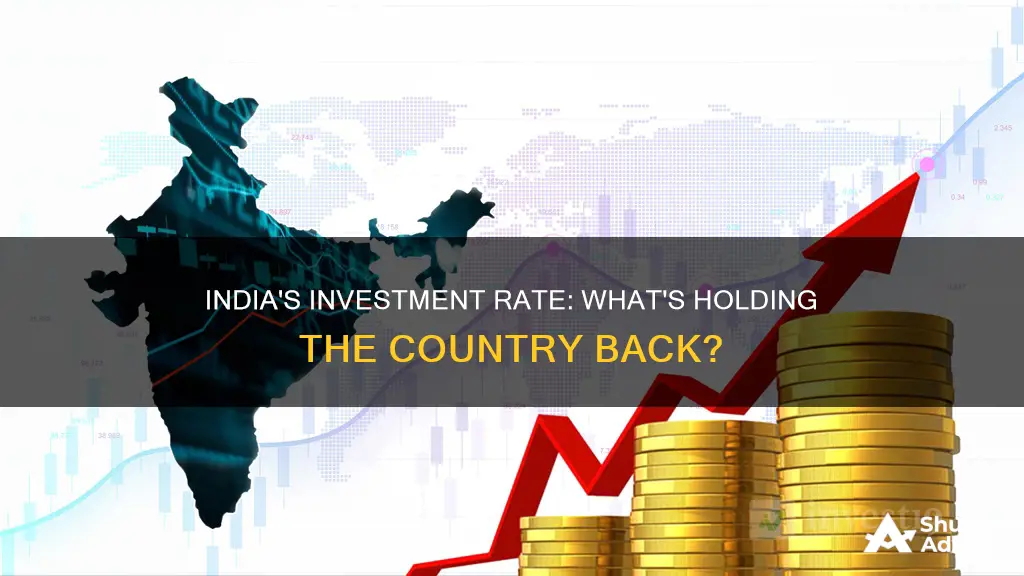
India's investment rate has been on a downward trajectory since the mid-2010s, with falling manufacturing growth rates and deindustrialisation. This decline is attributed to a combination of erratic policies, rampant cronyism, and heavy-handed investigation agencies. The country's investment rate is further impacted by the global economic slowdown, with disruptions in economic activities and supply chains due to the Russia-Ukraine war. Moreover, the banking sector's non-performing assets and the high cost of borrowing for corporates also contribute to the low investment scenario. To address this issue, India needs structural reforms, including land acquisition and bankruptcy laws, to create a conducive environment for investments and boost its economic growth.
| Characteristics | Values |
|---|---|
| Low investment rate | 20-25% of GDP |
| Low private domestic investment | 20-25% of GDP |
| Low Gross Foreign Direct Investment (FDI) | 2.1% of GDP |
| Lack of liberalised approach to political economy | |
| Lack of major reforms | |
| Financial problems of banks and corporations | |
| High real cost of borrowing |
What You'll Learn

Low investment rate due to erratic policy, cronyism, and political raid raj
Congress leader Jairam Ramesh has claimed that India has been locked into a cycle of low investment since 2014 due to "erratic policy and rampant cronyism" under the ruling BJP-led NDA government. He argues that the biggest component of investment, private domestic investment, has been underperforming since 2014, compared to the previous Congress-led UPA government. This has resulted in sluggish investment rates, dragging down medium and long-term GDP growth rates, wages, and consumption growth.
Ramesh further criticises the BJP government's economic policy, stating that their "sops" like corporate tax cuts and Production Linked Incentives (PLIs) are insufficient. Instead, he calls for a "freer society, polity, and economy", free from decisions like demonetisation, which he terms a "masterstroke", as well as cronyism and raid raj. He believes India needs a new, liberalised approach to its political economy rather than marginal policy tinkering.
The impact of erratic policies and cronyism on India's investment rate is also evident in the case of the Adani group. The Hindenburg report exposed extensive financial manipulations by the Adani group, enabled by cronyism and stock market manipulations. This has resulted in a spoilt investment climate, with investors scared away and a decline in internal investment.
Furthermore, the Indian economy has been characterised by a nexus between businessmen and politicians, with the former gaining protection and influence over key appointments in financial institutions and the bureaucracy. This has led to a lack of integrity and independence in these institutions, further exacerbating the issues of erratic policies and cronyism.
To address these issues, there are calls for an impartial inquiry and a Joint Parliamentary Committee (JPC) probe into the matter. However, the ruling BJP has strongly opposed these demands.
Managers Accepting Investments: Who's On Board?
You may want to see also

Lack of investment in infrastructure and manufacturing
Historical Context
India's economy has experienced a notable decline since the mid-2010s, marked by falling investment rates and a deceleration in manufacturing growth. This has resulted in a setback to overall growth, investment, and consequent deindustrialisation.
Infrastructure Development
The Indian government recognises the critical role of infrastructure development in achieving its economic goals. As such, it has implemented various initiatives and policies to boost investment in this sector.
Gati Shakti
The Gati Shakti initiative, also known as the National Master Plan for Multi-modal Connectivity, is a $1.2 trillion project aimed at streamlining the planning process and ensuring effective resource allocation for development. This project involves collaboration between different government divisions to work on infrastructure projects, including roads, railways, airports, ports, mass transport, and waterways.
National Infrastructure Pipeline (NIP)
The NIP is another key initiative introduced by the Indian government to augment infrastructure development. This pipeline involves an estimated funding of over $1 trillion over five years, with a focus on projects in the renewable energy sector that actively involve private participants.
Budget Allocations and Investments
The Indian government has demonstrated its commitment to infrastructure development through its budget allocations. For the fiscal year 2024-25, the government devoted about $134 billion to projects within the infrastructure sector, representing an 11% increase in spending compared to the previous year.
Additionally, the government has introduced various schemes and programmes to complement urban development with sustainability initiatives. For example, the "PM-eBus Sewa Scheme" aims to reinvent bus operations and encourage the use of public transport through payment security mechanisms.
Foreign Investment and Partnerships
India has also attracted foreign investment and formed strategic partnerships to support its infrastructure development goals. For instance, the National Investment and Infrastructure Fund (NIIF) was established as a collaborative investment platform between the Indian government, global investors, multilateral development banks, and domestic financial institutions.
Another notable partnership is with Japan, resulting in the creation of the India-Japan Fund through the Japan Bank for International Cooperation (JBIC). This fund has sanctioned $600 million for investments in sustainability and low-carbon emission efforts.
Impact of the COVID-19 Pandemic
The COVID-19 pandemic and the subsequent disruptions to the supply chain led India to focus on its "Make in India" initiative and self-reliance. This shift fueled the country's goal of infrastructure development, with central and state governments bringing in policies to facilitate the planning and execution of projects related to power, roads, and urban infrastructure.
Manufacturing Sector
The manufacturing sector in India has faced challenges, contributing to the country's economic slowdown.
Deindustrialisation and Import Dependence
India has experienced premature deindustrialisation, defined as a sustained decline in the output and employment in the manufacturing sector before attaining industrial maturity. This has resulted in India becoming an import-dependent economy, particularly relying on imports from China.
Make in India Campaign
The "Make in India" campaign, launched in 2014, aimed to boost the manufacturing sector. However, it has faced challenges, and its impact on the manufacturing sector's share of fixed investment has been limited.
Impact of the COVID-19 Pandemic
The pandemic further highlighted the structural issues in the manufacturing sector, as India faced difficulties in securing critical intermediate inputs, such as active pharmaceutical ingredients (APIs) for the drug industry and fertilisers for agriculture. This prompted the launch of the Atmanirbhar Bharat Abhiyan in May 2020 to promote self-reliance.
While India has made notable efforts to enhance investment in infrastructure and manufacturing, there are still challenges to be addressed. These include procedural delays, regulatory hurdles, and the need to balance urban transformation with sustainable development. Addressing these issues will be crucial for India to achieve its economic growth targets and improve the overall quality of life for its residents.
Shark Tank India: Investing in India's Future
You may want to see also

Financial problems of banks and corporations
India's financial system has witnessed significant growth and has a relatively stable approach given the current global economic outlook. However, the banking system in India has faced several issues, including:
- Non-Performing Assets (NPAs): The country's NPAs have crossed ₹10 lakh crores, with more than 70% originating from the corporate sector. NPAs occur when borrowers are unable to repay their loans, leading to significant losses for banks.
- Fraud: The RBI reported a total of 9103 fraud cases in 2022, with the biggest being the PNB scam of ₹11,000 crores.
- Lack of Banking Access: Around 69% of India's population, approximately 1.4 billion people, do not have access to formal banking services, according to a World Bank report.
- Limited Rural Reach: There is a lack of technical enablement and financial services in rural areas, making it challenging to serve this population.
- Losses in Rural Branches: Many rural branches of banks operate at a loss due to high overheads and the prevalence of the barter system in these regions.
- Large Overdues: Small branches of commercial banks face challenges with a large amount of overdue advances to farmers, further exacerbated by the former National Front Government's decision to waive loans up to ₹10,000 crores.
- Competition from Non-Banking Financial Institutions: Commercial banks face stiff competition from non-banking entities, such as mutual funds and housing finance corporations, which offer higher interest rates.
- Competition with Foreign Banks: Foreign banks and smaller private sector banks have registered higher deposit growth, possibly due to better customer service, leading to a potential diversion of deposits from nationalised banks.
- Bureaucratisation: The banking system has become burdened by red tape, long delays, a lack of initiative, and slow decision-making.
- Political Pressures: Nationalised banks face difficulties due to growing political pressures, which can influence personnel selection and loan grants without considering creditworthiness.
To address these issues, India has made efforts to promote financial inclusion, such as the Pradhan Mantri Jan Dhan Yojana initiative, which has led to 300 million individuals opening bank accounts for the first time. Additionally, the introduction of digital payments and the rise of Neo Banking are expected to revolutionise the banking sector.
Portfolio Investment vs Brokerage: What's the Difference?
You may want to see also

High real cost of borrowing
The high real cost of borrowing is a significant factor contributing to India's low investment rate. This is influenced by a combination of factors, including interest rates, bank policies, and economic conditions.
Firstly, interest rates play a crucial role in determining the cost of borrowing. When an individual or business takes out a loan, the interest rate applied can significantly impact the overall cost. Negotiating a fair interest rate is essential, as any rate above the bank's prime rate should be considered negotiable. Variable interest rates, which fluctuate over time, can also affect borrowing costs. Banks often prefer these to minimise the risks associated with lending to small businesses. As a borrower, negotiating a maximum interest rate cap can provide some certainty regarding the maximum exposure on the loan. Alternatively, borrowers may consider "buying" a fixed interest rate from the lender, which is typically slightly higher than the variable rate.
Additionally, various direct and indirect financial costs are associated with loans. Direct costs include interest rates, points, penalties, and required account balances. Points are one-time charges calculated as a percentage of the total loan amount. Upfront bank charges, such as document review fees, credit check fees, and loan processing fees, also fall under this category. Indirect costs, on the other hand, refer to loan conditions such as periodic financial reporting, maintenance of financial covenants, and subordination agreements. These requirements can be time-consuming and may involve additional expenses for the borrower.
The banking system in India also influences borrowing costs. Banks may require borrowers to maintain certain financial ratios, establish compensating balances, or provide personal guarantees. For example, a bank may ask a borrower to maintain a specified balance in an account as a condition of the loan, effectively reducing the principal amount and increasing the real interest rate. Personal guarantees, which make individuals personally liable for loan repayment, are commonly requested by banks and can be a significant burden for borrowers.
Moreover, the economic environment in India has impacted borrowing costs. The COVID-19 pandemic and the associated disruptions led to a decline in investment rates and a contraction in Gross Fixed Capital Formation (GFCF) in 2020. The banking sector also faced challenges, including the overhang of the NPA (Non-Performing Assets) issue and a liquidity crisis in the NBFC (Non-Banking Financial Companies) segment. These factors contributed to subdued bank credit off-take, affecting borrowers' access to funding.
Furthermore, the transmission of interest rate cuts by the Reserve Bank of India (RBI) has been sluggish. While the RBI has been taking efforts to push the bank credit cycle by lowering interest rates, the cost of borrowing for corporates has remained high. This disconnect between the RBI's actions and the actual borrowing costs experienced by businesses and individuals contributes to the overall high real cost of borrowing in India.
To summarise, the high real cost of borrowing in India is influenced by a combination of factors, including interest rates, bank policies, and economic conditions. These factors collectively contribute to India's low investment rate and can create a challenging environment for borrowers, particularly small businesses and individuals.
Investment Management SA: Strategies for Success
You may want to see also

Lack of political consensus for economic reforms
The Indian economy has historically been characterised by extensive government intervention and control. However, the economic liberalisation of the 1990s, prompted by a balance of payments crisis, saw the country transition towards a market-based economy. This shift in economic policy was not without its challenges, and a lack of political consensus for economic reforms has been a significant obstacle to India's economic growth.
The 1991 election, for instance, resulted in a fragile minority government led by P.V. Narasimha Rao. Despite the urgency of economic reforms, Rao's government faced a no-confidence motion just two weeks after he was sworn in as prime minister. The motion was passed with 241 votes in favour and 111 against, largely due to abstentions from the Left.
Rao's government did, however, manage to implement some significant reforms. These included the devaluation of the rupee, the dismantling of trade protection, the welcoming of foreign investment, and the announcement of public-sector disinvestment.
However, the pace of reform has often been inconsistent, with periods of mega reform punctuated by long spells of inaction. This can be attributed to the nature of India's parliamentary democracy, where leadership plays a decisive role in shaping policy. A determined leadership can often overcome resistance from opponents within and outside the government, as well as from vested interests.
The commitment to economic reform has also varied across different regional governments, with some states embracing liberalisation more openly than others. For example, the state of Kerala, known for its unique model of social development, has traditionally been reluctant to implement market reforms due to the influence of socialist ideologies and powerful trade unions. On the other hand, states like Haryana and Andhra Pradesh have demonstrated more policy stability and commitment towards improving their investment climate.
Overall, the lack of political consensus for economic reforms in India has resulted from the complex dynamics of its parliamentary democracy, regional variations, and the influence of powerful interest groups.
Claiming Investment Management Fees: Strategies for Tax Efficiency
You may want to see also
Frequently asked questions
India's investment rate has been low due to a combination of erratic policies, rampant cronyism, and the ED/IT/CBI raid raj.
The investment rate in India is between 20-25% of the GDP.
The primary cause of India's low investment rate is the country's sluggish private domestic investment, which has been in the doldrums since 2014.







